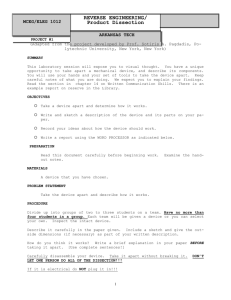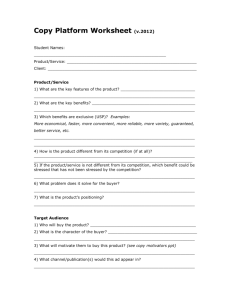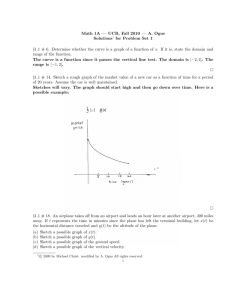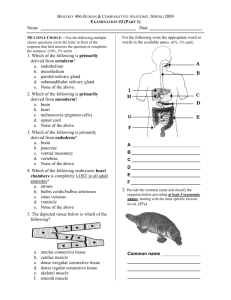EXPLOITATION OF MOBILE MAPPING FOR CREATION OF SURVEY SKETCHES
advertisement
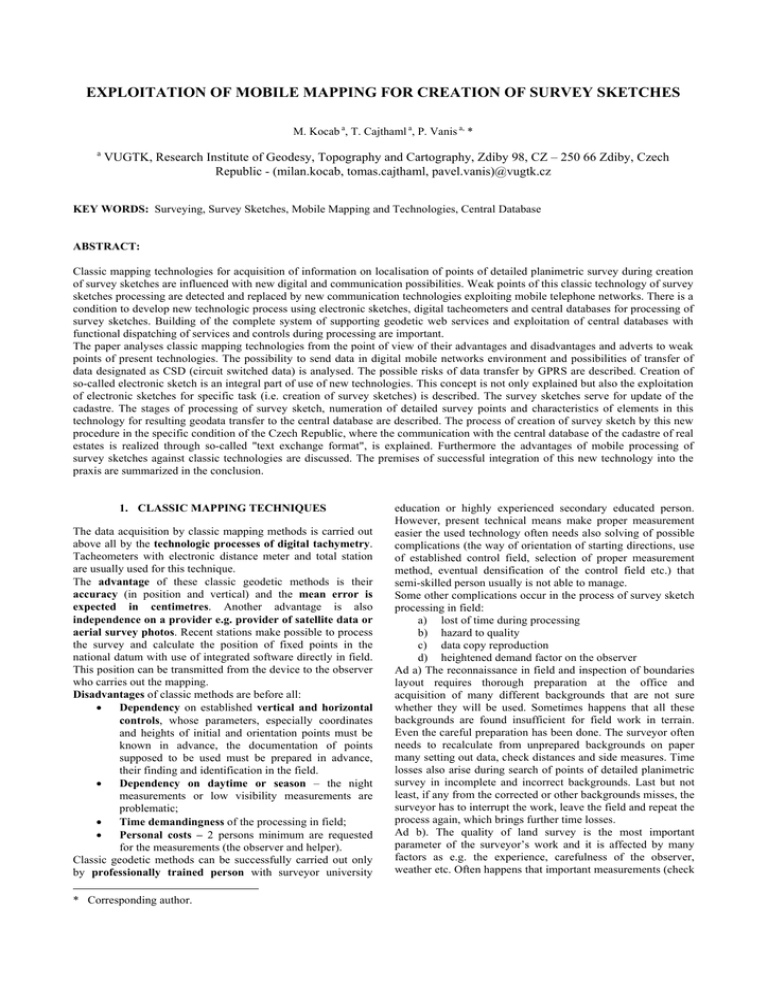
EXPLOITATION OF MOBILE MAPPING FOR CREATION OF SURVEY SKETCHES M. Kocab a, T. Cajthaml a, P. Vanis a, * a VUGTK, Research Institute of Geodesy, Topography and Cartography, Zdiby 98, CZ – 250 66 Zdiby, Czech Republic - (milan.kocab, tomas.cajthaml, pavel.vanis)@vugtk.cz KEY WORDS: Surveying, Survey Sketches, Mobile Mapping and Technologies, Central Database ABSTRACT: Classic mapping technologies for acquisition of information on localisation of points of detailed planimetric survey during creation of survey sketches are influenced with new digital and communication possibilities. Weak points of this classic technology of survey sketches processing are detected and replaced by new communication technologies exploiting mobile telephone networks. There is a condition to develop new technologic process using electronic sketches, digital tacheometers and central databases for processing of survey sketches. Building of the complete system of supporting geodetic web services and exploitation of central databases with functional dispatching of services and controls during processing are important. The paper analyses classic mapping technologies from the point of view of their advantages and disadvantages and adverts to weak points of present technologies. The possibility to send data in digital mobile networks environment and possibilities of transfer of data designated as CSD (circuit switched data) is analysed. The possible risks of data transfer by GPRS are described. Creation of so-called electronic sketch is an integral part of use of new technologies. This concept is not only explained but also the exploitation of electronic sketches for specific task (i.e. creation of survey sketches) is described. The survey sketches serve for update of the cadastre. The stages of processing of survey sketch, numeration of detailed survey points and characteristics of elements in this technology for resulting geodata transfer to the central database are described. The process of creation of survey sketch by this new procedure in the specific condition of the Czech Republic, where the communication with the central database of the cadastre of real estates is realized through so-called "text exchange format", is explained. Furthermore the advantages of mobile processing of survey sketches against classic technologies are discussed. The premises of successful integration of this new technology into the praxis are summarized in the conclusion. 1. CLASSIC MAPPING TECHNIQUES The data acquisition by classic mapping methods is carried out above all by the technologic processes of digital tachymetry. Tacheometers with electronic distance meter and total station are usually used for this technique. The advantage of these classic geodetic methods is their accuracy (in position and vertical) and the mean error is expected in centimetres. Another advantage is also independence on a provider e.g. provider of satellite data or aerial survey photos. Recent stations make possible to process the survey and calculate the position of fixed points in the national datum with use of integrated software directly in field. This position can be transmitted from the device to the observer who carries out the mapping. Disadvantages of classic methods are before all: • Dependency on established vertical and horizontal controls, whose parameters, especially coordinates and heights of initial and orientation points must be known in advance, the documentation of points supposed to be used must be prepared in advance, their finding and identification in the field. • Dependency on daytime or season – the night measurements or low visibility measurements are problematic; • Time demandingness of the processing in field; • Personal costs – 2 persons minimum are requested for the measurements (the observer and helper). Classic geodetic methods can be successfully carried out only by professionally trained person with surveyor university * Corresponding author. education or highly experienced secondary educated person. However, present technical means make proper measurement easier the used technology often needs also solving of possible complications (the way of orientation of starting directions, use of established control field, selection of proper measurement method, eventual densification of the control field etc.) that semi-skilled person usually is not able to manage. Some other complications occur in the process of survey sketch processing in field: a) lost of time during processing b) hazard to quality c) data copy reproduction d) heightened demand factor on the observer Ad a) The reconnaissance in field and inspection of boundaries layout requires thorough preparation at the office and acquisition of many different backgrounds that are not sure whether they will be used. Sometimes happens that all these backgrounds are found insufficient for field work in terrain. Even the careful preparation has been done. The surveyor often needs to recalculate from unprepared backgrounds on paper many setting out data, check distances and side measures. Time losses also arise during search of points of detailed planimetric survey in incomplete and incorrect backgrounds. Last but not least, if any from the corrected or other backgrounds misses, the surveyor has to interrupt the work, leave the field and repeat the process again, which brings further time losses. Ad b). The quality of land survey is the most important parameter of the surveyor’s work and it is affected by many factors as e.g. the experience, carefulness of the observer, weather etc. Often happens that important measurements (check distances, side measures, some detailed points…) are ignored during surveying and this fact is found in as lately as the surveyor returns to his office. Due to the fact that it would be time consuming, these small defects (often very difficultly discoverable) are not corrected and the work is finalised with some amount of “unreliability”. Ad c). Weak point is repeated making of (paper) copies for work in field and infinite rewriting of measured data. Once observed and created information should be exploited manifold without manual rewriting. Making of side calculations and their rewriting to sketches that will be also rewritten and thrown away because the target is a new “official” document (note of detailed change survey, survey sketch, setting-out sketch) makes the process long and it is source of errors. Ad d). The surveyor has to solve difficult numerical and imaging operations in very unfavourable conditions as dust, sun, rain, snow, frost, noise, impossibility to lay out the documentation and paper backgrounds… The computations must be carried out with extreme concentration whereas the conditions do not allow carrying out the work with corresponding quiet. The development of IT, especially the Internet, changes known ways of communication. The Internet provides much broader possibilities of widening and exchange of information than has ever been possible. The documents visualised in web browser can not be further processed and therefore the need to create a new tool appears. This tool should be simple, open for all (i.e. fully to disposition for all), updatable and also very universal. 2. USE OF MOBILE TELEPHONE NETWORKS There is a possibility of data transfer in frame of data services (CSD – Circuit Switched Data) in the digital mobile networks environment. These “data services” function in the same way as the voice transfer but the transferred data use the same data flow instead of original packed voice – effectively approximately 13.5 kbit/s. The GPRS (General Packet Radio Service) technology extends the network possibilities and proposes an alternative to described principle of circuit switching. The GPRS can be understood as a new network using existing GSM network and using the Base Transceiver System (BTS) and other components of the network infrastructure to be able to communicate with mobile terminals in the range of involved BTS, using the frequencies that are reserved for GSM. The transfer using GPRS takes place in slots that are in the moment not in use of GSM network for voice transfers. The GSM operator increases the use of existing transfer capacity by other equipment. Therefore the GPRS is relatively cheap. But it presents not guaranteed way of data transfer in case there are no free slots available in the specific cell – the transfer rate of GPRS dramatically decreases. The whole conception and GPRS standards rely on functionality of minimal data flow. Each GPRS station must have an IP address. The address can be static or dynamic. The system is fast enough and operative for the transfer of coordinates of measured points for survey sketch. At present the use of wireless technologies seem to be proper for needs of survey as the transfer of coordinates from a survey device (theodolite, total station) to the surveyor’s computer or to a server application with geodatabase that can communicate with client application on-line again through wireless technologies. The plan of situation in field is created from the measured coordinates on a special device (with stylus – tablet PC) that includes means for wireless communication. The communication schema is displayed in the image. Figure 1. The schema of designed data transfer from survey device to the tablet PC Two means of communication can be seen from the image: 1. using WiFi – proper mainly for shorter distances 2. in GSM network – restricted only by the GSM operator signal availability Such designed solution can be available to different groups of users, e.g. after following needs: • transfer of backgrounds after defined structure into the format that is set as input format to the database of ISKN (Information System of Cadastre of Real Estates) – current use of the technology • checking of survey sketches before their implementation to the geodatabase • Processing of complete survey sketch or field sketch including drawing creation and integration with preceding processes • Widening of the system by conversion and other functions 3. ELECTROCNIC SKETCHES The term “electronic sketch” means a set of sketch information in form of computer file for mapping methods that compare in field acquired data with the situation in valid map and these sets of information are visualised on a desktop of mapping device. Electronic sketches can be prepared in special mapping systems as DIKAT or MicroGEOS Nautil. Electronic sketches can be transferred to central database and adjusted there and the process of works can be monitored. Also combined solutions can be used, i.e. that individual wireless connected application can be combined. The technology of wireless data transfer use can be implemented into thick clients, like for example DIKAT is and the whole desktop application makes possible to solve direct communication with geodatabase where all geodata and data are stored. The connection of central database with a surveyor in field condition makes possible not only to send supplemental data (raster of vector) to field but also the calculations and other documentation. The connection of field surveyor with the central database operator solves weak points of processing of for example survey sketches. 4. EXPLOITATION OF ELECTRONIC SKETCHES FOR CREATION OF SURVEY SKETCHES 5. CREATION OF SURVEY SKETCHES IN MOBILE WAY The creation of survey sketches means set of processes needed for creation of new planimetric components in scales 1:1000 and larger. The real state in field is inspected in frame of continuous survey together with legal status stated in the cadastre of real estates and new status that will be validated after contribution in the cadastre. The process stages of creation of survey sketch are: • Advance working • Creation of minor control • Local on-the-ground examination • Detailed planimetric survey • Calculation of coordinates of detailed points • Creation of original print of new state • Area calculation • Establishment of database • Creation of exchange format for data and documentation • Final works The backgrounds for creation of sketches are copies or enlargements of cadastral and real-estate register maps, orthophotomaps or enlargements of aerial photos. Older documentation of survey sketches and notes of detailed change survey, allocation plans etc. should be also used. The extension of the sketch is an A4 format and they are prepared in scales 1:5000 to 1:100 depending on composition of mapped situation. The sketches are numbered in frame of the cadastral district and the detailed points in frame of notes of detailed change survey. Elements of sketches transferred to central database: • Proprietors of real estate • Location of administrative boundaries • Location of proprietor boundaries of parcels • Location of land-use boundaries • Location of protective zones and protected areas • Location of allotment boundaries • Nature of land-use • Buildings • Transport networks and equipments • Power lines • Water buildings • Other planimetric elements • Names on a map This task asks for transfer of new measured and certified points to the central server in prepared data structure. Other services like calculation of setting out data for detailed points or data for setting-out of indistinct boundary, data on proprietors, control and other operative information will be requested. The prerequisite of successful use of communication technologies is processing of survey sketches and notes of detailed change survey in digital form with sophisticated application programmes as e.g. DIKAT. The data are better to be prepared for publishing in form of internet application (map server) with use of so called geodatabase. This way then makes possible simpler form for handling with geodata – not only for publishing but also for editing. Other shared service for surveyors is an internet application for processing of data exchange format of new survey sketch. The server, that processes these services, guarantees actuality of the data format for transfer on the server of ISKN and the surveyor does not need to take care of it. Processing of the exchange format for survey sketches is run by projects. The work with project can be divided into several steps (with respect to beginning user). The user hands over the input data in packed form as upload files and their contents will be checked and unpacked. The proposed system distinguishes these three variants: 1. Digital cadastral map – survey sketches processed in localities with valid digital cadastral map • TXT file – new coordinates – measured • DGN – design with proposal of survey sketch – future state (exchange format) – contains only new and invalidated features • Exchange Format of the Cadastre – for concrete case from ISKN 2. Cadastral map – digitised – survey sketches processed in localities with cadastral map – digitised • TXT file – new coordinates – measured • DGN – design with proposal of survey sketch – future state (exchange format) – contains only new and invalidated features + measured data (before transformation, eventual adjustment) • Old exchange format – eventually Exchange Format of the Cadastre (new exchange format) 3. Seamless map • Technology equivalent with Digital Cadastral Map processing 6. ADVANTAGES OF MOBILE PROCESSING OF SURVEY SKETCHES Exploitation of mobile way of creation of a field sketch and subsequently the whole survey sketch complete new technology that makes possible to hand over the data to central database and also make the work orders via GPRS directly to surveyors in field. It will make possible especially to check the work progress from the office, send other materials and backgrounds to field, help during solution of unclear situation, help to precise the work order, define and consult the situation directly with proprietors in field on-line. Figure 2. Sketch of Local on-the-ground examination – field sketch 7. CONCLUSION The technology of mobile mapping designs complete and sufficiently fast way of survey sketches processing and reduces the time spent on field works, which makes possible to reduce costs. This technology asks for new work organisation, break old measurement habits, increase of baud rate, reliability and refinement of techniques and controls of creation of survey sketches in new way. The object is to create an internet (web) service, that will send XML documents. Simply said – it is a service that on the base of XML documents exchange can communicate with other geodetic services (servers) in the internet environment. Proposed solution requires completion and changes on the client and on the geodata provider sides and creation of web XML service. As has already been noted, the whole solution is modular and it can be adjusted to users. The further development of whole solution to web XML services environment including geodata standardisation and generalisation must be pointed out. REFERENCES Kafka, Š., 2004. The Characteristic of Web Services for Data Access, Their advantages and Imperfections. Report in (Management of Geographic Information and Knowledge – 2nd National Programme of Research TP2 – Information Society) , Czech Academy of Science, Prague. Kocáb, M., 2002. New Exchange Format of Cadastre of Real Estates Data and Land Adaptations. Land Adaptations, 2002 (41), pp.. 12-14. Kocáb, M., 2004. New Technologies of Measurement and Role of Field Sketches. In: Urban- rural interrelationship for sustainable environment: 2nd FIG regional conference. Marrakech, Morocco, pp. Technical Session TS 12, 5 pages. http://www.fig.net/pub/morocco/proceedings/TS12/TS12_4_ kocab.pdf (accessed 18 Oct. 2006) Kocáb, M., Cajthaml,T., 2006. Processing of ISKN Geodata Exchange Format with Exploitation of Web Application. In: GEOS 2006 Conference, Prague, Czech Republic. In print. Kocáb, M., Pražák, J., Soukup, L., Zaoralová, J., 2005. New System for Handling with Cadastral Maps Rasters. Report 1079/2005, VÚGTK, Zdiby, Czech Republic.
